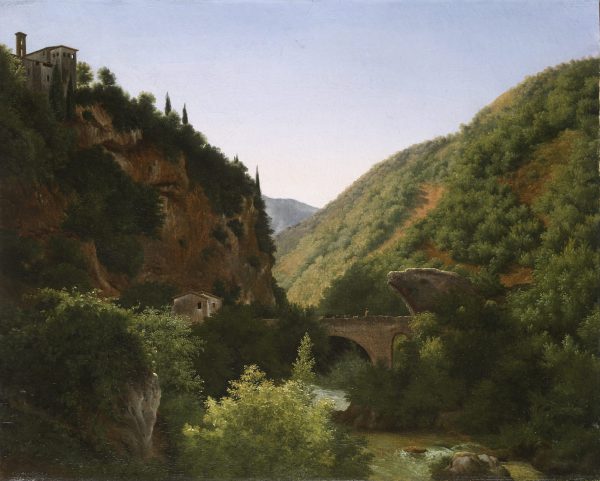Bridge and aqueduct in ruins, San Cosimato, 1807
Oil on paper laid down on canvas., H. 0.38 m; W. 0.47 m
Inscribed on the reverse: Pont et aqueduc en ruine à Saint Cosimato. / donné à François Bègue le 5 avril 1860, Comtesse de Turpin.
Provenance: The artist’s estate until his death.
Given by his wife to François Bègue in 1860.
Private collection, France.
Turpin de Crissé’s father, an amateur painter of some considerable talent, had himself produced some very attractive views which had been exhibited at the Salon of 1787. He was able to give his son a good basic training in the technical skills of drawing and painting. Proscribed as an émigré, his father travelled to America, joining a number of other exiles who hoped to build a new life, where he died alone and impoverished. Théodore, meanwhile, returned with his family to France. Thanks to the generosity of the Comte de Choiseul-Gouffier, the celebrated diplomat and archaeologist, he was sent at the latter’s expense to Switzerland in 1803 and travelled to Rome in 1807-1808.
For his first Salon entry in 1806 Turpin was awarded a gold medal with a literary subject, Les Adieux de René à sa soeur and a View of the Temple of Minerva at Athens, followed in 1808 by a View near Civita Castellana. He travelled several times through Italy painting many landscapes and “vedute”.
On his return to France, he was well received by the court of Napoleon and became the art adviser to the Empress Josephine, serving as her Chamberlain from 1809 until her death in 1814. A reliable royalist, Théodore Turpin de Crissé was highly esteemed by Charles X and the Bourbon Restoration, and served as Inspector for the Fine Arts from 1824 until 1830. He continue to exhibit at the Salon until 1835.
Our painting represents the aqueduct in ruins near Vicovaro, overhanged by the convent San Cosimato. The English artist Joseph Wright of Derby painted the same view at the end of the 18th century (private collection). This work is attributed to the first stay of Turpin de Crissé in Italy, as well as the drawing of the same subject illustrated in Turpin de Crissé, Paris 2006 no. 85 (Paris, musée du Louvre) and dated circa 1807-1808 by Caroline Chaine.
We are grateful to Mrs Caroline Chaine for writing the catalogue entry of this painting, which will be included in her forthcoming catalogue raisonné.
